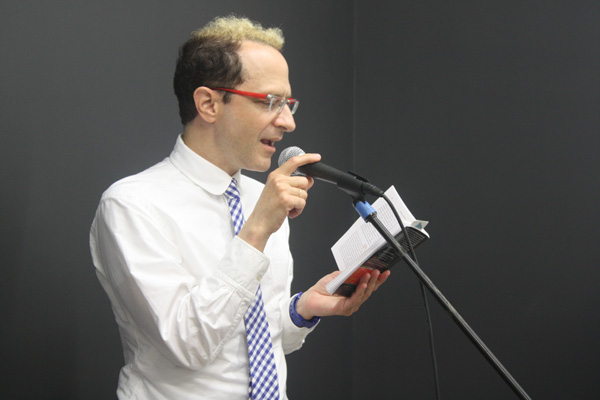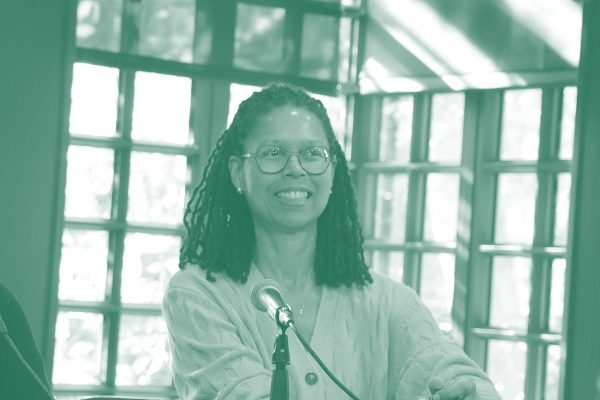
Talking with Wayne Koestenbaum, like reading his diverse body of work, is thrilling. I went rock-climbing for the first time recently and though the analogy to Wayne’s writing might seem like a stretch, bear with me. Looking for a foothold—on a rock-face or in Wayne’s universe—it turns out, requires creativity, a different kind of seeking, a looking both deeply and askance at what appears at first to be straight surface. Both demand an unusual combination of trusted instinct and hard work. When it all comes together, there arises an intoxicating pleasure that masks the fact that you are intensely vulnerable, that you are hanging precariously over an abyss. It is serious stuff. Wayne’s work—his poems, his essays, his criticism—obliterates any vestigial divide we might hold on to between play and thought. It revels in and broadcasts the risks and joys (the risky joys and joyful risks) inherent in both. In his most recent collection, My 1980s & Other Essays, he brings together a wild cast of characters and mix of approaches to unfold a theory of literature, art, and the world that is—in language he uses to celebrate the artists he admires—aphoristic and excessive, lacerating and unsummarizable, constrained and refusing restriction, aching and nuanced. Our conversation about the book took place over email in March 2014.
—Stefania Heim
Editors' Note: This interview is part of National Poetry Month at Boston Review, with "Trance Notebook #18," from Koestenbaum's new project.
Stefania Heim: Could you describe My 1980s & Other Essays? What holds the book together? How did it come into being?
Wayne Koestenbaum: Ever since I published my first collection of essays in 2000, Cleavage, I’ve dreamt of a second collection; I’ve aimed my essay-writing—though ostensibly “occasional”—in the direction of bouquet, and chosen subjects that might fit together to create, chorally, a sensibility. Many of the figures dominating the book make cameo appearances in the title essay—Roland Barthes, James Schuyler, Eve Kosofsky Sedgwick, Susan Sontag, Anna Moffo, Debbie Harry. And so I consider the opening essay, “My 1980s,” to be a list of dramatis personae, as well as a piece that establishes the tempo—fragmented, piecemeal, accretive—of the book’s utterances.
An earlier version of this book was nearly twice as long, and included essays on Mallarmé, Tennessee Williams, Fassbinder, my life as a pianist. With the help of my noble editor at Farrar, Straus and Giroux, Sean McDonald, I made the book much shorter, swifter. I miss Mallarmé and Williams and Fassbinder. I find omission a painful procedure, although, like a masochist, I weirdly enjoy the scission. My style depends on cutting. On dismemberment? (Perhaps metaphorically!) I sound “confessional” and lax in my writing, but in fact I prune ruthlessly and leave out embarrassing details.
SH: The book is teeming with figures: writers, artists, opera singers, porn stars. They are all so present within the text that, by midway through, I felt like I was at a bacchanalian gathering in the room of your imagination. Can you describe this gathering of characters outside of the confines of these essays?
WK: Yes to bacchanal! The “room” that houses my book’s figures (writers, artists, opera singers, porn stars) is a studio (like M-G-M, in the old days); a system (like the periodic table or the alphabet); an opera house with a roomy backstage, big enough to store sets for all of early Verdi (I Lombardi set-flats cheek-by-jowl with Un giorno di regno); an AMG (Bob Mizer’s Athletic Model Guild) brochure or catalog, the models’ attributes (preferred sexual position, penis size, etc.) signaled by hieroglyphs; a subway stop with a functioning john (“tea room”) and multiple transfers; an orientation session for new enrollees in the non-existent yet alluring New York School of Poets; a yard sale, where one may hope to stumble across an unattributed Forrest Bess that forever escapes the prison of the catalogue raisonné.
When I write, I stare at an imaginary door, window, tableau—a frozen thing, a scene, a gesture—and I groove into it, literally like a corkscrew.
SH: The collection also has so many potent scenes of encounter or almost-encounter: you behind Debbie Harry on line at “the unsavory supermarket”; you asking Anna Moffo for her autograph; you on the bus reading your stolen collection of Oppen’s poems. Do you—or will you—imagine an analogous scene of encounter with an imaginary reader?
WK: The reader is always younger—a relation (pederastic?) I perform in my essay “Advice to the Young.” When I was younger, I aimed my words at older readers. (Everyone authoritative seemed older.) Now, I aim words at younger readers. (This is partly a lie. I don’t aim words. I let words fall, or drop. Or I place them down on a surface, like Mahjong tiles.) And somehow I am always trying to convince this younger reader that I am still young, that I am in fact younger than the younger reader. I’m chasing the reader toward the vanishing point of childhood, infancy, conception.
SH: I have been thinking about your title, My 1980s, especially alongside the other markers of time in the collection. In your essay on Frank O’Hara, you describe his exciting “time-blur” and in “A Woman Alone in Her Room,” you write, “Numbers announce periodicity, ripple. 1911/1991. Thus we chart a blank space between two figures.” Both the marking and the complicating of structures of time seem central to you. Can you describe the theory of time you put into play in this book?
WK: My theory of time! Thanks for asking. Time is split. Time is doubled. The past isn’t over. The past lies in wait for us, as a future door. If you pay attention to an object, a sensation, a word, a color, anything, time will split in half. My goal is to slow time down and to unearth its motionlessness. Or: the reason I write is to tunnel into the past as the vestibule of the (sexy) future. The future is always sexy. (Am I avoiding death?) Time is plastic—ready to be molded, punctured, folded. When I write, I stare at an imaginary door, window, tableau—a frozen thing, a scene, a gesture—and I groove into it, literally like a corkscrew. Or else I let the gesture make a groove in me.
SH: One thing I find thrilling about your prose is how you flirt with the line between praise and censure. You call Marianne Moore’s prose “ornery;” Susan Sontag’s sentences “stern, self-conscious, tense.” All the while I feel you to be thoroughly celebrating these qualities.
WK: I like difficult writing. I like obscurity. I like slowness, turgidity, weirdness, uncooperativeness. I like bad behavior, bad manners. I like writing when it seems that the author is ruining things, “blowing it,” falling into a cesspool of mistake and fallacy. I like writing that courts self-destruction: autophagous writing. Self-cannibalizing writing. And so to praise a writer I love, I need to point out his or her truculence—in order to celebrate it. Genet’s valorization of betrayal comes to mind. I don’t want to betray the writers I worship, but I need to point out their love affair with the morass, with the boggy and the incorrigible.
SH: You also manage an astonishing and subtle collision of registers. I’m thinking of “www. MyPornEssay .com,” in which you describe yourself as a “transparent eyeball”—Emerson’s figure for man’s search for the divine in nature—as you eat your “ricotta salata and asparagus.” How do you pull this off?
WK: Transparent eyeball, ricotta salata: they happen simultaneously. They collide—in time, in space. In a room. (Food Bar, Chelsea, 2004.) Food Bar no longer exists. The professor under whose tutelage I first read Emerson—Joel Porte—is now dead. But the phrase “transparent eyeball”—as a code for how to comprehend experience—occurred to me when in 2004 I was writing about lunch with porn star Michael Lucas in Food Bar, and the pallor of the ricotta salata, its strange compromise between tastiness and unpleasantness, equaled the whiteness of an eyeball, and the transparent windows of Food Bar, and no-privacy transparency of a porn star’s relation to being-seen. These strands of experience all come together, and to explain their convergence is a lifetime’s task, and is too much trouble, and so I rely on imagistic cheeky shorthand, quick collisions, based on reasonably accurate reportage of what actually happens to me and what actually passes through my mind.
SH: About James Schuyler’s art criticism, you write: “Criticism, not a parasitic genre, is governed by the same charmed tenets as poetry.” What do you see as the relationship of this book to categories of criticism or poetry? How do your essays relate to your poems? Do you find divisions between genres to be useful?
WK: My writing process—whether I’m pursuing poetry or prose—is always the same. I try to get language going. I try to stir up verbal embers, to start a fire. And then, once the fire starts, I try to make sure that it doesn’t burn down the universe. But when I’m building the fire—the entire process of drafting a poem or an essay—my only concern is to keep the flame singing. This process takes a great deal of inner friction, and ready access to combustible materials. The incendiary materials are easily obtained, and stay close at hand; but the internal friction is chancy. It’s not a matter of mood. (I can be in a terrible mood, and still work up the friction necessary to produce sentences.) But I need a certain degree of forcefulness—call it aggression, or nervousness, or wish, or lust, or hunger. I need to crave.
SH: Speaking of lust: “If you want me to describe him, I will,” you say of the hunky UPS man who comes to your door in 1989. I would like you to.
WK: I think that if I’d described the UPS man in my essay, no one would have cared. But because I didn’t describe him, and told the reader to ask me to describe him, many readers have obliged. The answer I usually give: “he looked like Sal Mineo’s hunky brother.” But for you, Stefania, I’ll be more precise. He looked like John Travolta, but without the chin dimple. He had a “pumped” (buff?) body, very wide arms (big biceps). Dark-haired. See, I can’t describe him! He is to me now an apparition—and I can only sketch his presence by pointing to movie stars who are either dead or no longer as cute as they once were.
SH: “What unknown avenues do your apples open?” you ask in your essay-letter to Freud. What is the secret apple of your own text?
WK: Maybe my inability to describe the UPS man is the secret apple of my text: the inability to describe, and the ambivalent obsession therefore with aim. With purposiveness. With stylistic scission—precision—crossbow-juxtapositions. Freud’s apple is really not an apple, it is the hat his father wore, the hat an anti-Semite knocked off the father’s head.
SH: What new projects—of description or failed description—are you working on?
WK: My new project is a book-length poem, tentatively titled The Pink Trance Notebooks. For approximately one year (November 30, 2012 through January 1, 2014) I kept notebooks in which I let myself write (as if in a trance) with a swiftness and chanciness and feverishness that I’d kept distance from and now longed to re-obtain. I transcribed the notebooks, and then created from the pile of material a series of approximately 34 assemblages, nine or ten pages each.
I started painting in September 2010, and this new practice has dominated my life ever since. On that subject, I could say more, and more, and more! My favorite pink is dianthus pink—either in a tube from the Williamsburg paint company, or in an R & F pigment stick. Dianthus pink pigment stick smeared over a canvas primed with black gesso creates an effect more important to me than Freud’s apple, though Freud’s apple helps me frame a sentence in which I can enclose my love for dianthus pink.
Photo: Ad Hoc Vox / Andrea Bellu.







